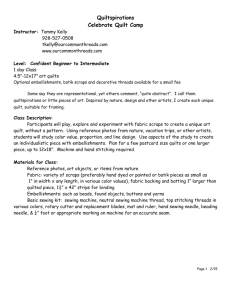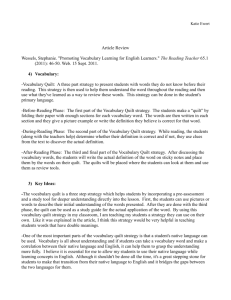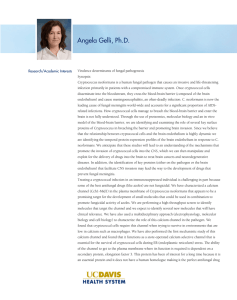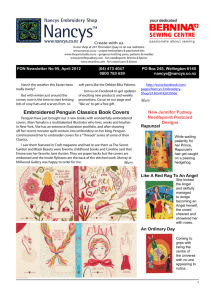To Wrap Yourself in Gratitude: Gelli Plate Lesson
advertisement
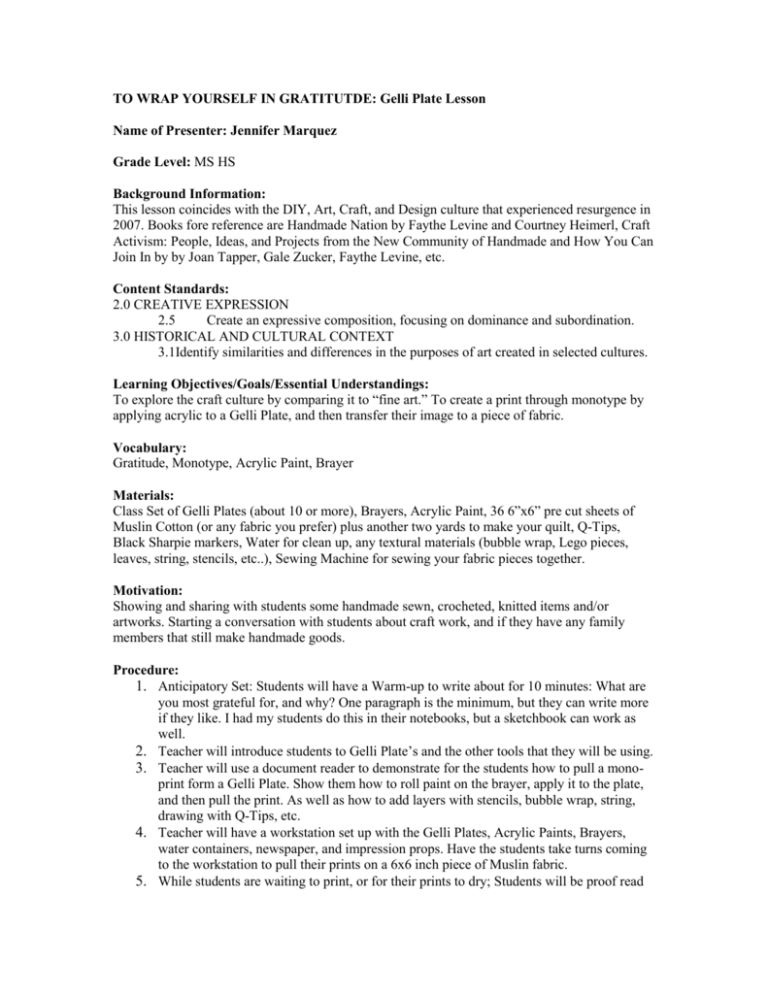
TO WRAP YOURSELF IN GRATITUTDE: Gelli Plate Lesson Name of Presenter: Jennifer Marquez Grade Level: MS HS Background Information: This lesson coincides with the DIY, Art, Craft, and Design culture that experienced resurgence in 2007. Books fore reference are Handmade Nation by Faythe Levine and Courtney Heimerl, Craft Activism: People, Ideas, and Projects from the New Community of Handmade and How You Can Join In by by Joan Tapper, Gale Zucker, Faythe Levine, etc. Content Standards: 2.0 CREATIVE EXPRESSION 2.5 Create an expressive composition, focusing on dominance and subordination. 3.0 HISTORICAL AND CULTURAL CONTEXT 3.1Identify similarities and differences in the purposes of art created in selected cultures. Learning Objectives/Goals/Essential Understandings: To explore the craft culture by comparing it to “fine art.” To create a print through monotype by applying acrylic to a Gelli Plate, and then transfer their image to a piece of fabric. Vocabulary: Gratitude, Monotype, Acrylic Paint, Brayer Materials: Class Set of Gelli Plates (about 10 or more), Brayers, Acrylic Paint, 36 6”x6” pre cut sheets of Muslin Cotton (or any fabric you prefer) plus another two yards to make your quilt, Q-Tips, Black Sharpie markers, Water for clean up, any textural materials (bubble wrap, Lego pieces, leaves, string, stencils, etc..), Sewing Machine for sewing your fabric pieces together. Motivation: Showing and sharing with students some handmade sewn, crocheted, knitted items and/or artworks. Starting a conversation with students about craft work, and if they have any family members that still make handmade goods. Procedure: 1. Anticipatory Set: Students will have a Warm-up to write about for 10 minutes: What are you most grateful for, and why? One paragraph is the minimum, but they can write more if they like. I had my students do this in their notebooks, but a sketchbook can work as well. 2. Teacher will introduce students to Gelli Plate’s and the other tools that they will be using. 3. Teacher will use a document reader to demonstrate for the students how to pull a monoprint form a Gelli Plate. Show them how to roll paint on the brayer, apply it to the plate, and then pull the print. As well as how to add layers with stencils, bubble wrap, string, drawing with Q-Tips, etc. 4. Teacher will have a workstation set up with the Gelli Plates, Acrylic Paints, Brayers, water containers, newspaper, and impression props. Have the students take turns coming to the workstation to pull their prints on a 6x6 inch piece of Muslin fabric. 5. While students are waiting to print, or for their prints to dry; Students will be proof read and revise their paragraphs, and then getting two other students to proof read their work. 6. Once the acrylic paint is dry on the fabric, have the students will write their paragraphs what they are grateful for on their prints with a Sharpie marker. 7. Students will submit their finished piece to be added to a class quilt. I used Fiskars How to: Quilt tutorial to make my quilt http://www2.fiskars.com/SewingQuilting/Projects/Tools-and-Techniques/Sewing-for-Beginners/How-toQuilt#.VFUmrfTF-8M 8. Final: Students will help piece together the quilt and decide which pieces fit together the best aesthetically. Assessment and/or Evaluation: Students will write a critique on the final design of the quilt, and how their personal piece contributes to the quilt. They will also include a comparison between what they are grateful for and what another classmate is grateful for. Extensions: If you have the documentary Handmade Nation, you could show some of that to them as well so that they can see the effects of the craft culture in America today.


